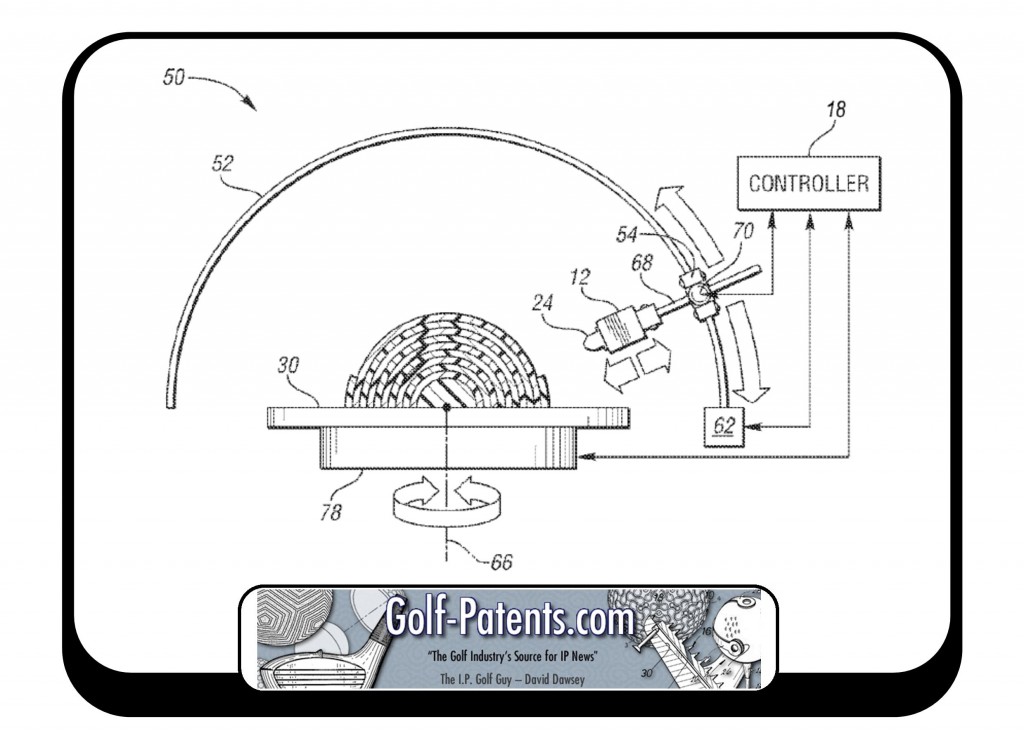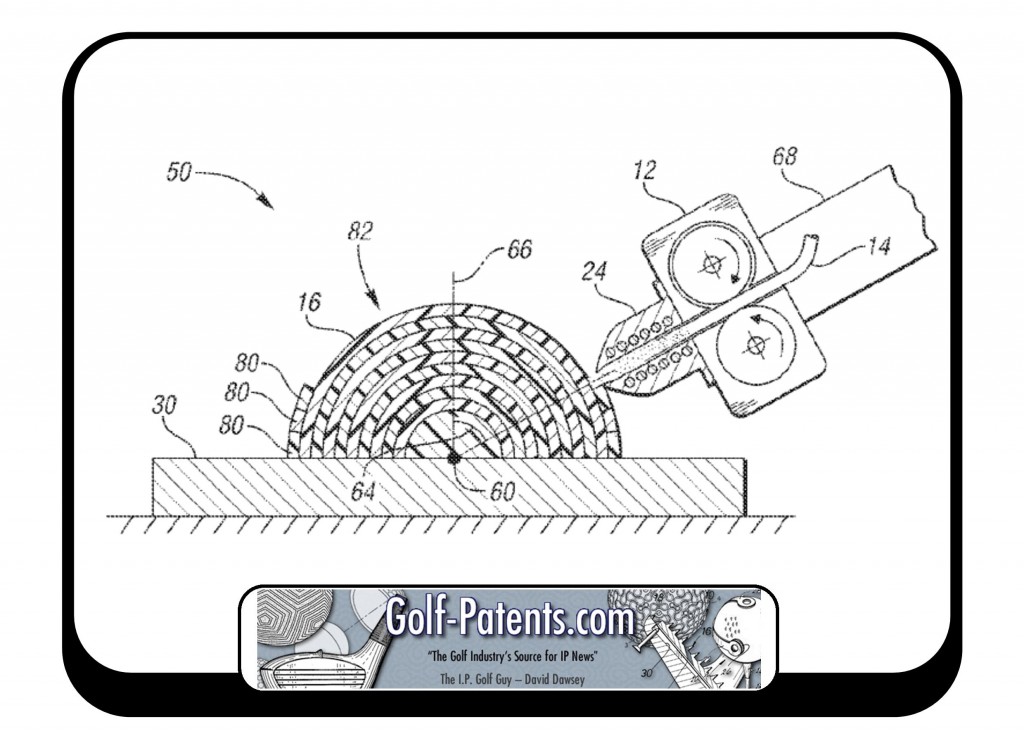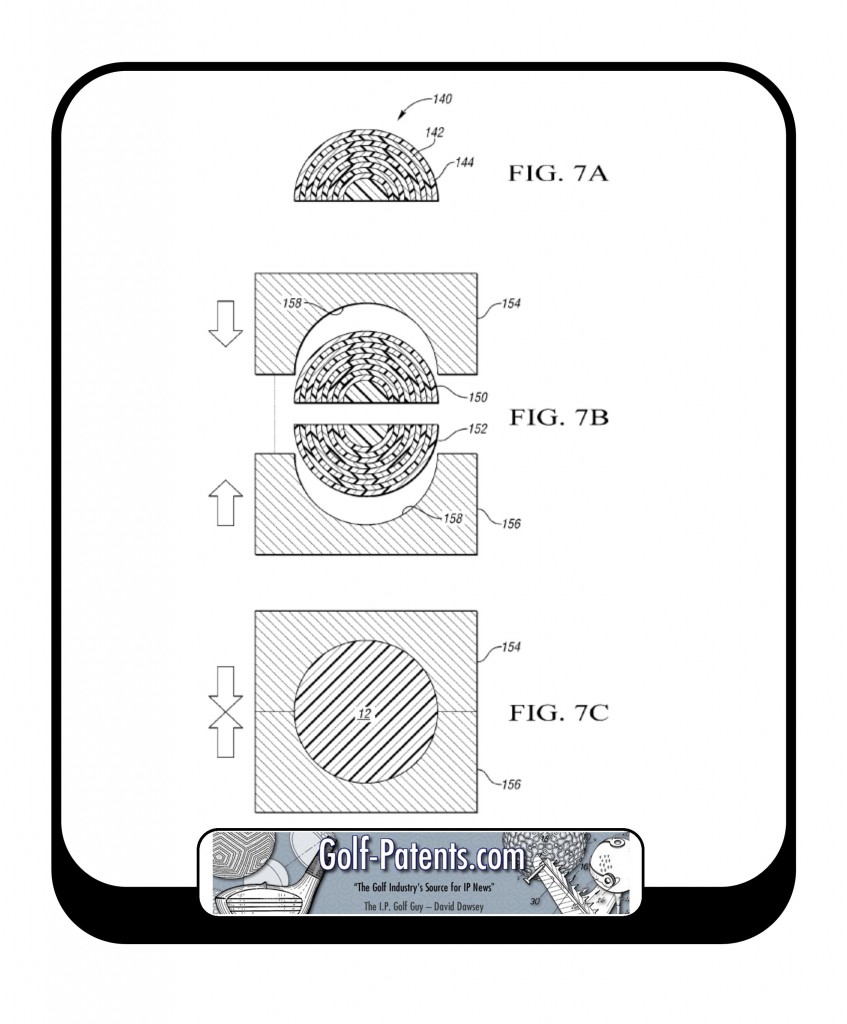I Can Only Imagine How Good I Will Play Once I Get My Hands on a 10 Piece Ball
If a 3 piece ball is good, and a 5 piece ball is better, one can only imagine how good a 10 piece ball would be. Read that with a strong hint of sarcasm, since if most golfers were honest, they would not be able to identify a 3 piece ball from a 5 piece ball in a blind test.
Nonetheless, golf equipment companies have to always be thinking 5-10 years down the road, and Nike has their sights set on 3-D printed golf balls. In fact, just this week they were granted a patent with the boring title “3D Printer with Native Spherical Control,” and one doesn’t have to dig too deep to see what they have in mind. The patent, USPN 9,339,975 describes the invention as:
| A three dimensional printer includes a work surface, an arcuate track disposed within in a track plane that is orthogonal to the work surface, a carriage slidably disposed on the track and translatable relative thereto, and a print head supported by the carriage. The track has a constant radius of curvature extending from a point on the work surface. The print head is translatable in a radial direction relative to the track, and includes a nozzle defining a print orifice, a mixing cavity disposed within the nozzle and in fluid communication with the orifice, and both a first and second filament feeder, each configured to controllably advance a respective filament into the mixing cavity at a respective feed rate. The print head further includes a heating element in thermal communication with the mixing cavity and configured to melt each of the first filament and the second filament. |
The patent goes on to mention in passing:
|
FIG. 3 schematically illustrates a 3D printer 50 that is natively controllable in a spherical coordinate system. As shown, the 3D printer 50 can create a hemispherical object with a continuous edge profile, and that does not have as noticeable of a stair-stepped edge contour. In general, this style of printer may be particularly useful when building a spherical or hemispherical object through a plurality of radially incrementing shells, such as may be used to form the core of a golf ball. |
And yes, they do have a pending application directed specifically to a “3D Printed Golf Ball Core,” which provides a little more information:
|
In one configuration, a golf ball core 12 may be formed by individually printing two polymeric core portions/hemispheres, and subsequently fusing them together to form a solid sphere. For example, as shown in FIG. 7A a 3D printer may begin by forming a solid object 140, via a plurality of layers 142. Each layer 142 may be formed by molding a plurality of discrete rings 144 or arcs in an arrangement that collectively forms a shell. Once two identical hemispheres 150, 152 are formed, they may be fused or molded together, such as schematically illustrated in FIGS. 7B and 7C. As shown in FIG. 7B, a pair of opposing mold halves 154, 156 may cooperate to define a spherical recess 158 that has a diameter about equal to the diameter of the hemispheres 150, 152. The hemispheres 150, 152 may be inserted within the spherical recess 158, upon which the mold halves 154, 156 may be brought together and heated to a temperature that is at or above the melting point of the polymeric hemispheres 150, 152. The application of heat may soften and/or partially melt the hemispheres 150, 152 as the polymer is heated by the mold. Once the hemispheres 150, 152 are brought to an appropriate temperature, the mold may be allowed to cool (or may be actively cooled), which may resolidify/harden the polymer, resulting in the hemispheres 150, 152 being fused together to form a sphere. In one configuration, this process may further involve compression molding an intermediate layer about the core, where the heat of the compression molding process fuses the hemispheres 150, 152 together. In other embodiments, the halves may be fused together through other methods of joining, such as spin welding, ultrasound welding, or laser welding. In another configuration, such as shown in FIGS. 8A-8C, the 3D printer 20 may form the core 12 by directly printing an outer-core material 170 onto a pre-formed inner core 172. In this method, an inner core 172 may first be formed using a molding technique such as injection molding, compression molding, or casting. The inner core 172 may then be placed into a recess 174 in the otherwise planar work surface 40. The recess 174 may have a diameter about equal to the diameter of the inner core 172. The 3D printer 20 may then print a first outer core portion 176 onto the inner core 172, such as shown in FIG. 8A. Once the first outer-core portion 176 is formed, the partially formed core assembly 178 may be flipped and the outer core portion 176 may be inserted into a second recess 180 in the work surface 40 (such as shown in FIG. 8B). The 3D printer 20 may then complete the assembly of the core 12 by printing a second core portion 182 (identical to the first outer core portion 176) onto the partially formed core assembly 178, such as shown in FIG. 8C. Therefore, as generally described in relation to FIGS. 7A-7C and 8A-8C, the golf ball core 12 may be formed by printing a first core portion and printing a second. Each respective core portion may include a respective plurality of concentric shells. The process may also include fusing the first core portion with the second core portion to form the core. As shown in FIG. 7A-7C, this may involve a distinct process, such as fusing via a heated mold, or, as shown in FIGS. 8A-8C, the fusing may occur by virtue of printing the second core portion directly onto the first core portion (i.e., where the molten material may temporarily melt a localized portion of the first core portion to cause a the two portions to be fused together). 3D printing may have certain definite advantages over other molding/forming techniques such as injection molding or compression molding. In particular, when using multi-filament capable print heads, such as schematically illustrated in FIGS. 4-6, 3D printing may provide an economical and method of creating a core 12 with a variable material composition. . . . While it is common to construct a golf ball by radially stacking three to five discrete material layers (e.g., by overmolding or compression molding the layers in succession), multi-material 3D printing allows for a more gradual transition/gradient, rather than a discrete boundary. In a conventional, discrete-layered multi-piece or multi-layer ball design, each layer may have the tendency to react differently to the stress imparted by an impact. In particular, due to the varying characteristics of the materials used, the stress/strain response of the ball may be non-uniform/non-linear across the ball, particularly at the boundaries between different materials. These non-uniformities may result in the occurrence of stress concentration points during an impact, which, over time, may degrade the performance of the golf ball 10. The more gradual transition presented through 3D printing may make the boundary effects less apparent. In addition to causing stress concentration points, the existence of discrete material boundaries may also result in non-uniform stress propagation during the impact. That is, during an impact, forces imparted to the ball may initially be localized at the point of impact. Over a short period of time (e.g., less than 500 μs), these stresses may propagate throughout the ball, where they are eventually converted into other forms of energy and/or dissipated. This stress propagation may be viewed as a pressure wave that induces one or more dynamic viscoelastic deformations, including vibrational modes, of the golf ball 10. The viscoelastic dissipation that dampens any acoustic waves may have an effect on the acoustic response of the ball to a player, and the viscoelastic responses to the impact stress may have an effect on the response of the ball during and after the impact. By blending the transition zones and eliminating stark, discrete boundary interfaces, the efficiency of the force transmission between the different materials and/or portions of the ball is increased, and the amount of energy that is dissipated at impact is correspondingly decreased. In another embodiment, the various layers that are printed may include discontinuities, or voids that may either remain unfilled (i.e., as pockets of air within the ball), or may be filled with another material. Said another way, at least one layer may be discontinuous, meaning that it is not formed from a single, homogeneous material composition; instead, it may include one or more voids (filled or unfilled) disposed through the shell. With a filled void, the filler material may be either printed in place, or may be filled through an overmolding process, such as injection molding. The use of strategically placed voids through one or more layers may be used to change the structural, acoustic, or dynamic properties of the ball. |
Here comes the 9000 yard course!
Dave Dawsey – The Golf Attorney
PS – follow me on Twitter (@GolfPatents) and sign-up HERE to receive posts via email.
PPS – If you like what we are doing, please considering helping us out and make your online gear purchases through our Amazon affiliate link. Every little purchase helps us keep the site up and running! Thanks.




